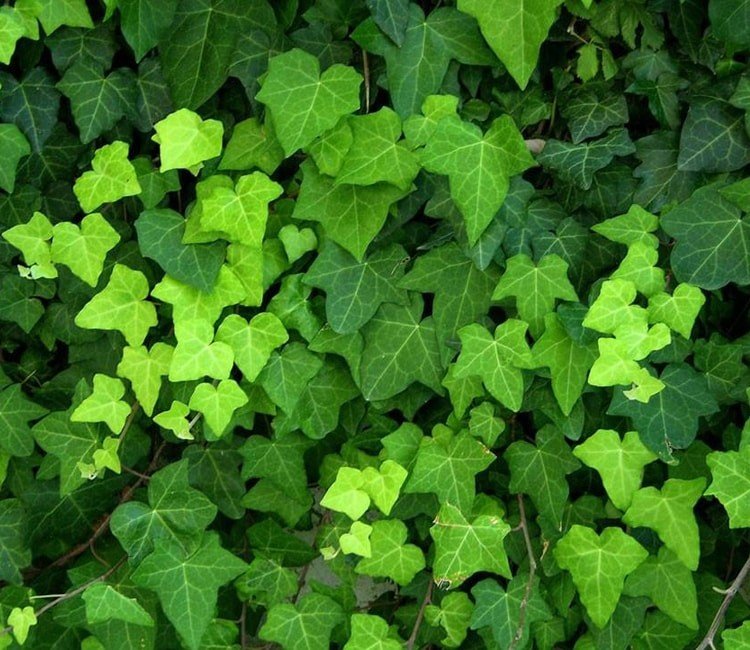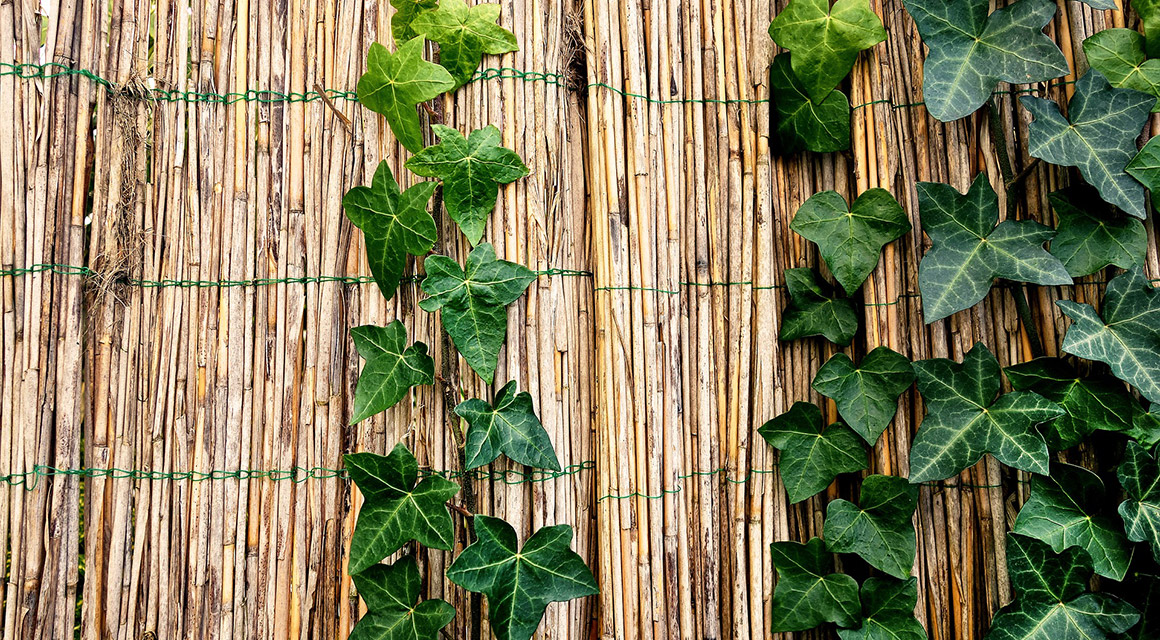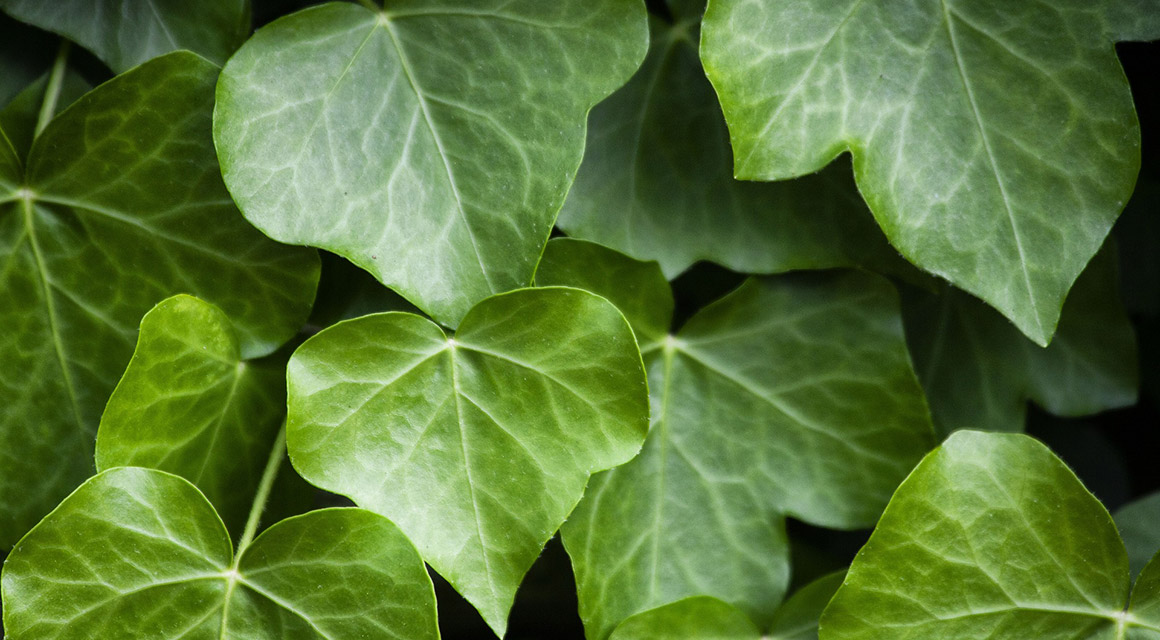The ivy is a well-known evergreen climbing plant that can form narrow hedges on wire mesh grids, for example. The ivy needs this wire mesh lattice, because as a climbing plant it cannot remain upright on its own. In the wild, therefore, it also grows along walls and trees, which can then provide the necessary stability. So in the garden we use ivy as a hedge, which can then grow along a wire mesh trellis for proper stability. Ivy also has a reputation for being a particularly fast-growing climber. Therefore, we are happy to tell you more about how fast an ivy grows.
Ivy is an extremely fast-growing climbing plant, which spreads not only in height, but also on the ground. Ivy is therefore very popular as a privacy screen on the fence, for greening the facade or grown as ground cover in the garden. How fast does ivy grow?

Contents
- 1 At first ivy grows slowly
- 2 The common ivy (Hedera helix)
- 3 How fast does ivy grow as a privacy screen?
- 4 Care of ivy
- 5 Regular pruning is important
- 6 Ivy can become a weed
- 7 How fast does ivy grow along a wire mesh screen?
- 8 Care for ivy
- 9 How can I redirect an ivy?
- 10 How Fast Does Ivy Grow? | Effectively Accelerate Growth
- 11 Ivy vigor
- 12 Growth in several stages
- 13 From an age of about three years
- 14 Age form after ten years
- 15 Accelerate growth
- 16 Location and soil.
- 17 Fertilization
- 18 Regular pruning
- 19 Note the toxicity of ivy
- 20 Author
At first ivy grows slowly
In the first few years, the growth of ivy is not yet so pronounced. However, once the plant has settled in the garden, you can almost watch it grow.
In a favorable location with sufficient moisture but without waterlogging ivy sometimes grows up to two meters per year.
Ivy not only grows in height when it finds sufficient support on walls, fences or trees, it also spreads on the ground. It is therefore popularly planted as ground cover or for grave planting.
At a certain age, usually from about ten years, ivy reaches its age form. It then grows upwards like a shrub and no longer spreads via climbing vines.
In its old-age form, ivy prefers sunny locations and forms flowers in the fall and fruits later. The fruits are very poisonous and must never get into children’s hands.
The ivy is known to grow quickly. So our customers regularly ask us the question, “How fast does ivy actually grow?” Most often, we hear this question from customers who wonder how long it takes before their ivy provides sufficient privacy protection. So in this blog post, we’d like to explain in more detail how fast ivy grows.
The common ivy (Hedera helix)
At Hedge PlantsTotal, we sell the popular ivy Herdera Helix. The common ivy is so popular because it thrives particularly well in our climate. Ivy is also not picky about its location: it grows both in the sun, in partial shade or in the shade. Its specially shaped, dark green leaves form a dense foliage. The ivy belongs to the evergreen hedge plants. Its foliage therefore provides privacy even in winter. Enough reasons, therefore, to choose an ivy hedge.
How fast does ivy grow as a privacy screen?
Ivy is a climbing plant. This means that it does not grow upwards “by itself”. The ivy needs something to climb up on. If you want to use an ivy as a privacy screen, let the Hedera climb up a trellis. Have a little patience! Even though ivy grows quickly, young ivy plants need some time to completely cover the trellis. In winter, ivy hardly grows at all, but in spring and summer you can almost watch the Hedera grow. An ivy hedge grows opaque within three years.
Care of ivy
Ivy can grow up to two meters per year. This is desirable in the first years, of course, because the ivy hedge quickly grows opaque. However, the plant does not stop growing once it reaches your desired height. The ivy wants to keep growing and will form new shoots both on the sides and upwards. If the Hedera is not trimmed regularly, the wild growth can get out of hand. In a cottage garden, of course, this can be intentional and add to the coziness of the garden. In a small garden, however, you should trim the ivy twice a year to prevent it from taking up too much space. When an ivy hedge is regularly pruned, the base of the hedge grows especially dense. So regular topiary also contributes to the compactness of the hedge or screen.
Regular pruning is important
To prevent ivy from overgrowing the entire garden in a short time, you must prune it regularly. This is especially true if it grows on the wall of the house. As soon as the tendrils reach the windows or the roof, shortening is called for.
If ivy is grown as a hedge, it should be cut back at least once a year and also thinned out a bit. This prevents diseases.
Ideal privacy screen even in winter
As problematic as ivy growth can be, as a hedge, ivy is ideal in the garden. Unlike other hedge plants, ivy is evergreen and forms a dense privacy screen even in winter.
The care of ivy is very simple. Other than regular pruning, ivy does not require any other maintenance.
Ivy can become a weed
Due to its rapid spread, ivy can become a dreaded weed in the garden. Eradication is costly. Before choosing ivy as a privacy plant or facade greenery, you should consider a few points:
- Ivy needs to be pruned regularly
- Ivy must not be grown on every wall
- Ivy cannot be removed from walls without leaving residue
- How do you cut ivy at a high height?
- Where to put the trimmings?
- Ivy is poisonous – for humans and animals
- Ivy is difficult to remove
Tips
If you have a lot of ivy in your garden, large amounts of prunings will accumulate in later years. You cannot put these clippings in the compost. An alternative are collection points for green waste, which are offered by many municipalities.

How fast does ivy grow along a wire mesh screen?
How fast the ivy can grow along a wire mesh also depends a little on the variety of ivy. The common ivy (in Latin: Hedera helix) has slightly smaller leaves and grows a little slower than the Irish ivy (in Latin: Hedera hibernica), which has larger leaves. However, for both varieties of ivy, it takes about three years to fully grow over a wire mesh trellis. If you want to have a full-grown ivy hedge faster, then we can always still use the ivy elements from our prefabricated hedges. Then, immediately after planting, you will have an opaque hedge and plenty of privacy in your garden. The wire mesh trellis should also always be anchored between two wooden posts, so that it has a stable hold. Click on the link planting ivy if you want to learn more.
Care for ivy
Initially, it is a great advantage that the ivy is a fast-growing plant. Namely, you will then get a pretty, opaque hedge in a relatively short time. However, the ivy keeps growing and growing, even if the hedge has already reached the height you want. In order to keep the growth under control, the ivy should therefore be pruned at least twice a year, so that the plant does not become too wide. If you cut the hedge at least twice a year, the result will be a wonderfully balanced hedge that will still have enough strong, green leaves on the underside, making it well opaque over the entire area. So if you cut an ivy hedge often enough, it will also remain wonderfully narrow and is then also suitable for smaller gardens.

How can I redirect an ivy?
The plants need a little help to grow well along and through a wire mesh. First, skillfully direct the longer branches up so that the plants will reach a wonderful height. After that, you should skillfully direct the branches to the left and right sides. This will then allow you to redirect the branches later to fill any holes in the hedge. The ivy grows mainly in height it usually likes to grow exactly where other branches are already. After all, it does not like wind so much and therefore it will always try to avoid wind by itself. That is why it needs your help. However, with an ivy you will definitely have a fast-growing evergreen hedge in your garden.
Guide the branches in the direction you want by snaking them through the wire mesh. However, you can also tie the small branches with a special cord or elastic PVC cord. Do not use rope, metal wire or cable ties, because they will drill into the wood of the branches as they grow larger and thicker.
So, an ivy hedge is an ideal hedge for both larger and smaller gardens if you are willing to put some effort into caring for the ivy. Timely care and pruning of the ivy is therefore important. You will then have an evergreen, opaque hedge in the garden, from which you can then also expect a lot of protection and privacy.
How Fast Does Ivy Grow? | Effectively Accelerate Growth

This strong-growing, evergreen and perennial plant thrives more or less well in different locations and does not require special care. Most often it is used for greening walls, for hedges or as a screen and ground cover. The leaves of ivy are particularly decorative. Depending on the variety, they can be deep green or intensely patterned. Growth vigor can also vary within species and cultivars.
Ivy vigor
Ivy is widely known for its rapid growth and ability to easily attach itself to a wide variety of surfaces. Not only can it climb high, but it can also spread over a large area on the ground. If it is then not cared for appropriately, especially pruned, it can quickly become a massive problem. Both positively and negatively, the vigor of this plant is influenced by the particular site conditions, fertilization and regular pruning. But how fast does it actually grow and can you influence it?
Growth in several stages
Hedera helix can reach an age of up to 500 years, depending on the variety and prevailing conditions. At the same time, the maximum growth rate per year, under optimal conditions, can be more than 200 cm. In this regard, it should be known that the growth of ivy proceeds in several stages or stages. The first stage, as a young plant, includes the first two years. From the third to the tenth year, the plant is in the middle stage. After about ten years, the so-called old-age form is reached. Depending on the growth stage, the annual growth varies.
As a young plant
Young plants refer to freshly grown plants, for example from cuttings. As a rule, they are planted out in the garden in the spring, as soon as they are rooted. In the first year of standing they grow only very restrained, usually less than half a meter. The growth rate is also limited in the following two years. The plants now put most of their energy into forming new roots and the first tendrils with adhesive roots.
From an age of about three years

The typical vigorous growth begins about the third year. With increasing root formation, the tendrils with adhesive roots become stronger. The ivy constantly forms new shoots and tendrils with which it grows up facades or creeps across the ground. In doing so, it tries to escape the light as much as possible and looks for shady corners. In this way, it can gain between five and ten meters in height and width over the next few years, provided it is not pruned.
Age form after ten years
After about ten years, when the ivy has reached its old age
age form, it no longer spreads via tendrils, but grows shrub-like and only in height. In contrast, young plants form only tendrils with adhesive roots. From this stage on, the now stately plant looks like a tree, it reduces growth and thus also the growth rate by about half. Nevertheless, it continues to grow clearly recognizable and can now be cut into any shape if necessary.
Tip: Ivy grown from young shoots forms tendrils and can be grown as a climbing plant. If, on the other hand, it is propagated in the age form, cuttings will develop into upright, shrubby, non-climbing plants.
Accelerate growth
There are different factors that can accelerate the growth of ivy:
Location and soil.
- Location and soil have a significant influence on growth rate
- Especially in the first years
- Growth of ivy fastest under optimal conditions
- Pay attention to good site conditions
- Locations with high humidity, plenty of shade and permeable soils ideal
- Growth rate here, more than 200 cm per year
- Annual growth lower in places with a lot of sun and moist soil
- About 150 cm in one year
- In winter there is a risk of sunburn here
- Growth on poor soils, in places with a lot of sun, low humidity, lowest
- Is significantly less than 100 cm per year
Tip: In general, it can be said that ivy grows faster, the shadier the place and the more constant air and soil moisture.
Fertilization
Normally, once ivy is well established in a location, it does not need to be fertilized. However, if the growth of the plants is to be accelerated, fertilization is another possible option.
- Growth acceleration especially useful for young plants
- Especially in the first six weeks after planting.
- Now additional fertilizer can stimulate plant growth
- additionally stimulate
- Especially the supply of nitrogen and potassium
- Horn shavings and compost are suitable organic fertilizers
- Commercially available liquid or slow-release fertilizers are also suitable
- Best time for appropriate fertilizer applications from mid-March to the end of July
- Apply organic fertilizers such as compost and horn shavings in spring
- If possible, distribute between the individual tendrils
Regular pruning

Pruning Hedera helix is mainly used to contain the growth or cut the plant into shape. But after pruning, it also sprouts again particularly quickly. In the first few years, pruning should still be restrained or minimal. It is only after about three to four years that it increases its growth significantly and begins to sprawl uncontrollably. Then it is time for simple pruning measures. The best time for this is around July/August. At this time, possible gaps are best identified. The older the ivy is, the faster it grows as well. This means that, especially older specimens, should be cut back a second time in spring or fall. Radical cuts are also no problem.
Tip: The cuttings should be completely collected from the ground and, if possible, not disposed of in the compost. Otherwise, the cut shoots can easily regain a foothold and spread elsewhere.
Note the toxicity of ivy
Ivy (Hedera helix) belongs to the poisonous plants. This is due to the toxins falcarinol and triterpenaponin, which are contained in all parts of the plant and have a toxic effect. In sensitive individuals, skin contact may cause rashes and allergies. Eating the leaves and especially the fruits can cause symptoms of poisoning in both children and pets such as cats. The plants do not form the highly poisonous berries until they are old. They ripen in spring and should not get into children’s hands.

